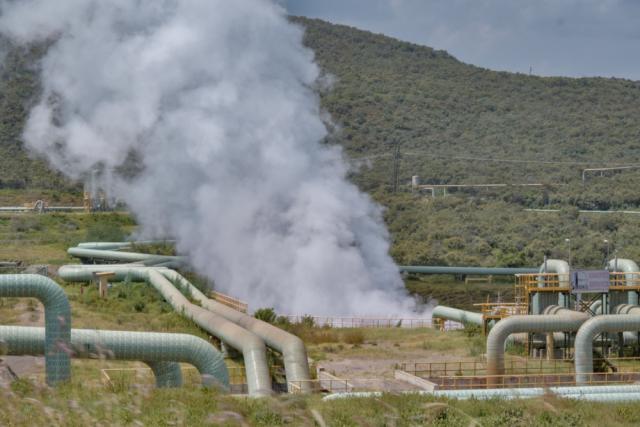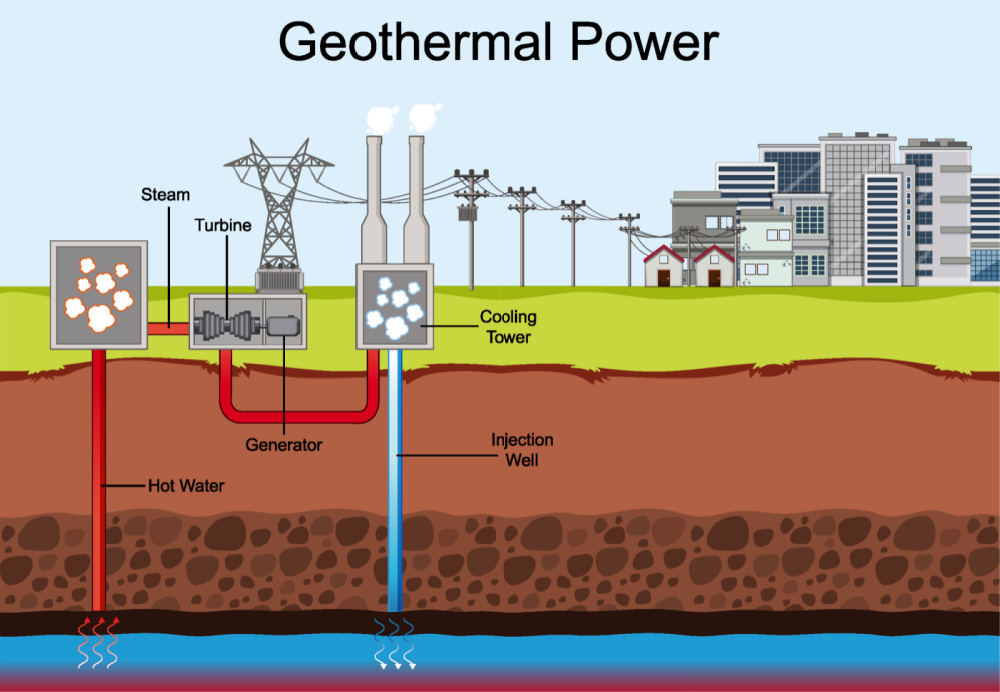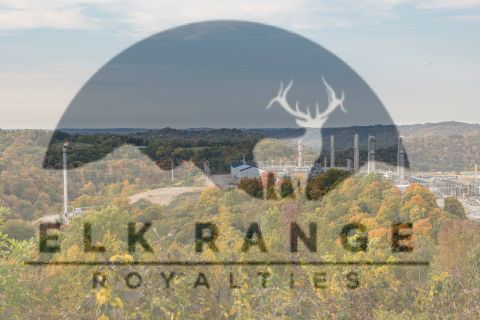
Steam vents from a geothermal power generation plant in Kenya. (Source: Stanley Njihia/Shutterstock.com)
Eureka moments happen when oil producers and geothermal energy professionals come together, according to Jamie Beard, executive director of the Geothermal Entrepreneurship Organization at the University of Texas at Austin.
However, it’ll take more than talk to move what she called the “red-headed stepchild of renewables” from the slow lane.
The oil sector, along with its cost-reducing, efficiency-boosting technologies and techniques, may be the force to jumpstart geothermal. In turn, geothermal could become a growth engine for the oil industry, elevating its ESG cred on the Street.
“Everything about oil and gas needs to be applied to geothermal right now,” Beard said during a recent SPE Live event with panelist Marit Brommer of the International Geothermal Association (IGA).
Beard, who spoke about what the two sectors could learn from each other as the world transitions to cleaner forms of energy, recalled conversations with oil and gas players about their use of managed pressure drilling, and their shock when learning the technology wasn’t being used in the geothermal sector.
Geothermal energy taps heat within the subsurface of Earth with wells drilled into reservoirs. Temperatures can range from 60 C for shallower depths to 380 C or higher at deeper depths, stretching about two to 12 miles beneath the Earth’s surface. Energy is carried to the earth’s surface via water or steam. The heat produced can be used to heat or cool homes and buildings via direct use heat or to generate electricity.
RELATED: Geothermal Energy Production: Playing It Cool to Realize Its Potential
Geothermal power, however, is not on track to meet net-zero emissions goals by 2050, according to the International Energy Agency (IEA). Geothermal electricity generation increased only by an estimated 2% in 2020 compared to the prior year. Turkey, Indonesia and Kenya were behind most of the growth in capacity additions, which the IEA said averaged 500 MW per year in the last five years.
To meet net-zero goals, 13% annual increases in generation are needed through 2030.
Brommer and Beard agreed that geothermal has huge potential, and the oil and gas industry is well-positioned to help.
“Geothermal, in my mind, is the one avenue that over the coming decades would actually allow the oil and gas industry to grow instead of retract using core competency,” Beard said. “I’m not talking about pivoting into solar. I’m talking about using current skill, current assets, current workforce.”
Tapping Technology
Similarities lie subsurface as both drill into reservoirs for its fluids, Brommer pointed out, noting the target is obviously different with geothermal seeking hot water, steam and brines at temperatures that can get as hot as 450 C.
Besides drilling, commonalities also include exploration and reservoir management.
“If you look at the type of subsurface settings and the reservoirs that we’ve been targeting, it’s predominantly volcanics; it’s granites; it’s your continental margins,” Brommer said of the geothermal sector. The industry could benefit from the advanced drilling technology knowledge of the oil and gas industry for asset optimization, she said, though developers of geothermal energy have had success with its drilling technology.
Conventional geothermal utilizes hydrothermal systems in which water is injected into the ground, heated by hot rock formations and pumped back to the surface, where the heat is extracted and power generated, panelists explained. If subsurface conditions are insufficient, such as not having water or poor permeability, enhanced geothermal systems (EGS) and closed-loop systems may be used. With EGS, water is injected at high pressure to create fractures using an injection well, and a second well is drilled to intersect the fractures and bring the water to the surface.
“Some of the closed loop concepts have multiple wells. Some of them are pipe in pipe, single well systems and that’s in the pure closed-loop category,” Beard said, noting startups are active in this area. “There’s even closed-loop concepts that are aiming to reuse existing oil and gas wells for the purposes of producing heat but in a closed-loop format. Closed loop is really interesting because if you do achieve a true closed loop, you can use non-water working fluids. There, you can optimize and engineer your working fluid to perform better than water.”
Brommer added there are some good examples of co-production. Vermilion Energy Inc.’s operations in France, where the company is the largest oil producer, is among them. Its oil operations provide geothermal heat to industrial-scaled agriculture and eco-friendly housing projects, the company said in a September investor presentation.
“Our oil operation produces a mix of hot oil and water, which comes out of the ground naturally heated to 60 C,” Vermilion said. “Hot water is sent through a closed-loop heat exchanger with the Tom D’Aqui greenhouse heating system. Water is reused by pumping it back underground in an enhanced oil recovery waterflood project.”
Finding Scale
While the geothermal and oil sectors can be complementary, there are differences that call for closer collaboration to get all players on the same page. Business models are different with geothermal having more direct relationships with its customers, being more local instead of global, Brommer noted.
Well diameters, flow rates and structural geology are other areas that don’t sync.
“Where you place your well for oil might not be the best [location] for water,” Brommer said “And because you’re after the water in the reservoir, you may not need to be on top of the structural anticline, for instance. That has a huge impact on the business case because either you need to do another infill well or you need to configure the well or you do all kinds of things to it in order to make it flow to where you want it to flow.”
Energy density has also been a challenge for geothermal development; however, “advances in energy conversion technology are beginning to place lower enthalpy (defined as the amount of energy in water or steam) resources within reach,” according to the 2021 Green Pipeline Project report released by the IGA.
“These resources are far more prolific and include many developed oil and gas fields. These fields are populated with infrastructure and a technical workforce. The stored thermal energy of the Williston Basin, a major energy basin straddling the U.S.-Canadian border, is four orders of magnitude greater than its oil reserves,” the report states. “Even with the poor conversion efficiencies of today’s low enthalpy ORC [Organic Rankine Cycle] systems the geothermal energy in the basin will outproduce the oil reserves on the electrification side. Plus, the stored thermal energy will recharge on a century scale, an attribute the oil reserves do not share.”
Scale is a potential gamechanger.
In the U.S. from 2015 to 2019, there were only 13 exploration wells, 24 production wells and 31 injection wells drilled for electrical geothermal resources, according to the 2021 U.S. Geothermal Power Production and District Heating Market Report released by the National Renewable Energy Laboratory.
“If we did 10x or 100x or even 1,000x of what we’re doing now in terms of development, it’s still too small to make a dent, particularly if you’re looking at future world energy demand in 2050,” Beard said. “We’ve got to [find] a vehicle to make that leap into geothermal energy at oil and gas scale. If we were drilling, say, 50,000, 60,000, 80,000 wells a year globally, … for 20 years straight, all of a sudden we’re talking about numbers, just in terms of electricity production, that are extraordinarily significant.”
Multiwell pad drilling is among the pages Beard wants to pull from the oil industry’s playbook to reduce costs and optimize geothermal drilling sites. “A lot of startups that are coming into the geothermal space with oil and gas brains are speaking that language, and that’s really promising.”
LEARN MORE: SPE Virtual Workshop: Bridging the Gap Between Geothermal and Oil & Gas
Recommended Reading
Elk Range Royalties Makes Entry in Appalachia with Three-state Deal
2024-03-28 - NGP-backed Elk Range Royalties signed its first deal for mineral and royalty interests in Appalachia, including locations in Pennsylvania, Ohio and West Virginia.
SilverBow Gears Up for Proxy Fight with Kimmeridge
2024-04-09 - Both SilverBow Resources and Kimmeridge Energy Management have proposed a slate of candidates for the board of directors with a vote set for May 21.
Kodiak Gas Services Closes $850MM Deal for CSI Compressco
2024-04-02 - Kodiak Gas Services’ acquisition of CSI Compressco was financed as an all-equity transaction valued at approximately $854 million, including assumption of $619 million in debt.
Kimmeridge Withdraws SilverBow Deal to Focus on E&P’s ‘Broken’ Board
2024-04-16 - Investment firm Kimmeridge said it had withdrawn its offer to combine its Eagle Ford E&P with SilverBow Resources as it promotes a slate of independent directors for SilverBow’s board at the company’s May annual meeting.
Is Double Eagle IV the Most Coveted PE-backed Permian E&P Left?
2024-04-22 - Double Eagle IV is quietly adding leases and drilling new oil wells in core parts of the Midland Basin. After a historic run of corporate consolidation, is it the most attractive private equity-backed E&P still standing in the Permian Basin?






